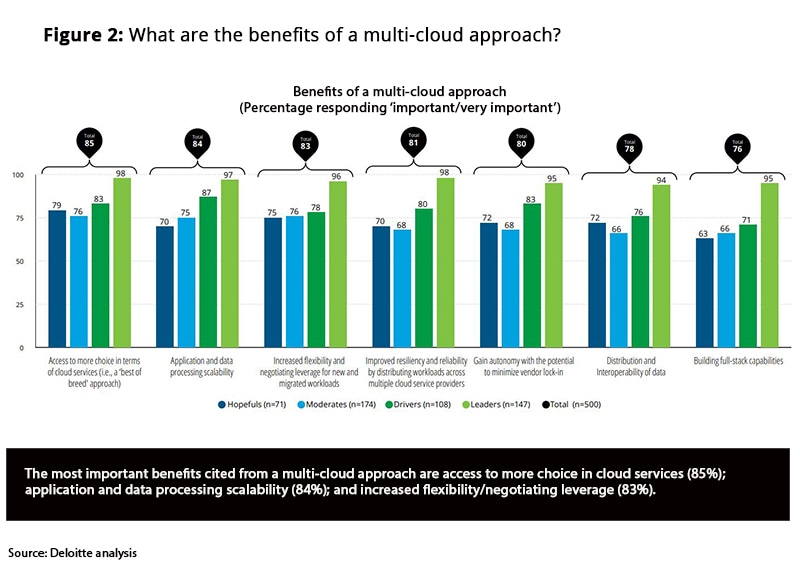Cloud Leaders Embrace Mature Multi-Cloud Architectures and Strategies | Deloitte US has been saved
A blog post by Diana Kearns-Manolatos, senior manager, Center for Integrated Research, Deloitte Services LP; Cathleen Domes, chief operating officer, Cloud Services, Deloitte Consulting LLP; Chris Thomas, US banking sector leader, Cloud Services, Deloitte Consulting LLP; David Linthicum, chief cloud strategy officer, Cloud Services, Deloitte Consulting LLP
Multi-cloud strategies bring together multiple cloud service providers, and multi-cloud has become the prevalent approach to cloud migration among US organizations that have moved to cloud. According to Deloitte’s new US Future of Cloud Survey Report, almost 80% of organizations overall state that they currently deploy a multi-cloud approach. Among all respondents, the top benefits organizations expect to get from multi-cloud investments include more choice, best-of-breed services, application and data scalability, and greater flexibility.
However, not all multi-cloud strategies are created equal. In fact, survey data shows that multi-cloud strategies and expected benefits differ by sector, with cloud Leaders1—those organizations that are reaping the most value from cloud—taking distinctly different actions from their peers. To identify cloud Leaders, the survey analysis grouped survey respondents into four organizational profiles (Leaders, Hopefuls, Moderates, and Drivers) depending on how they ranked their strategic priorities and the extent to which they reported a high level of success at driving innovation across those priorities.
Cloud Leaders have higher multi-cloud adoption levels and distinct strategies
As organizations progress on their multi-cloud journey, they can learn much from cloud Leaders. For instance, Leaders have a higher multi-cloud adoption rate (86%) than Hopefuls, Moderates, and Drivers (figure 1).
Leaders also implement key strategies that set them apart from their peers, such as:
- Reduced dependence on on-premises solutions. Leaders’ migration to the public cloud is roughly on par with Hopefuls, Moderates, and Drivers, but Leaders’ ability to move workloads not just to cloud, but off-premises in general, is better. For example, Hopefuls have 32% of workloads still on-premises. Leaders have reduced on-premises workloads to just 19%.
- The right balance of service providers in a multi-cloud strategy. Leaders tend to have three to four cloud service providers, whereas the majority of Hopefuls, Moderates, and Drivers have only one or two.
- An expectation of more benefits from multi-cloud. Access to more choice (85%) is the top benefit respondents seek from their multi-cloud investments. However, Leaders understand that attaining value is about more than choice—it’s about strategy execution. Leaders scored higher overall across every multi-cloud benefit category—expecting more individual benefits, and at greater numbers, for each category. For example, Leaders’ top benefit priority areas were distribution and data interoperability (94%) and building full-stack capabilities (95%). Conversely, only 66% of Moderates expected to benefit in these areas. This difference underscores the importance of developing not just horizontal, multi-cloud architectures, but full-stack vertical solutions that allow data to move seamlessly, regardless of cloud provider. Figure 2 outlines benefits of a multi-cloud approach.
Industry sectors prioritize multi-cloud benefits differently
Cloud benefit priorities and benchmarks differ by industry. For example:
- Access to more choice and building full-stack capabilities are prioritized most by life sciences and health care organizations
- Increased flexibility and negotiating leverage are most important to technology, media, and telecommunications respondents
- Improving resilience and reliability is a leading benefit for consumer and financial services organizations, more so than for other industries
- Gaining autonomy and avoiding vendor lock-in are important to the energy, resources, and industrials and life sciences and health care sectors
- Data interoperability is a top area for consumer sector respondents, while it’s less of a priority for financial services organizations, which place more importance on data scalability
This variation in expected benefits by industry could be, in part, because certain sectors are further along in their multi-cloud adoption than others. For example, our analysis found that consumer and financial services (84% for both) are the top two leading industries in terms of taking a multi-cloud approach. Energy, resources, and industrials (72%) and technology, media, and telecommunications (77%) clearly still embrace a multi-cloud approach, but they have lower multi-cloud adoption.
Moving forward
Given varying adoption levels, what companies in particular sectors seek to gain from their multi-cloud investments will differ. Nevertheless, industries that aren’t as mature in their multi-cloud adoption journey can look to leading sectors and cloud Leaders to guide their multi-cloud strategies. They might also consider other strategies—such as leveraging industry clouds and a focus on creating a mature software engineering culture—that are helping Leaders to gain greater value from their cloud investments.
To learn more about other strategies and actions that set Leaders apart, read “Purposeful—not greater—investments set cloud innovation leaders apart” or our full US Future of Cloud Survey Report.
1 Leaders were the top 29% of respondents who achieved the greatest strategy and innovation value from their cloud investments.
Get in touch

Diana Kearns-Manolatos
Diana Kearns-Manolatos is a senior research leader with Deloitte Services LP’s Center for Integrated Research, where she leads Deloitte’s global research on digital transformation.

Cathleen Domes
As chief operating officer of Deloitte’s Cloud business—and most recently the managing director who was instrumental in standing up Deloitte’s Analytics offerings—Cathleen has cemented her position at the forefront of Deloitte’s largest and most important investments. She executes on some of Deloitte’s most strategic initiatives and is at her best when producing, directing, and managing teams, which affect large scale change in the world of business. Name one of Deloitte’s largest transformation and modernization efforts and you’re apt to find Cathleen’s footprints. Her experience with Deloitte spans more...



